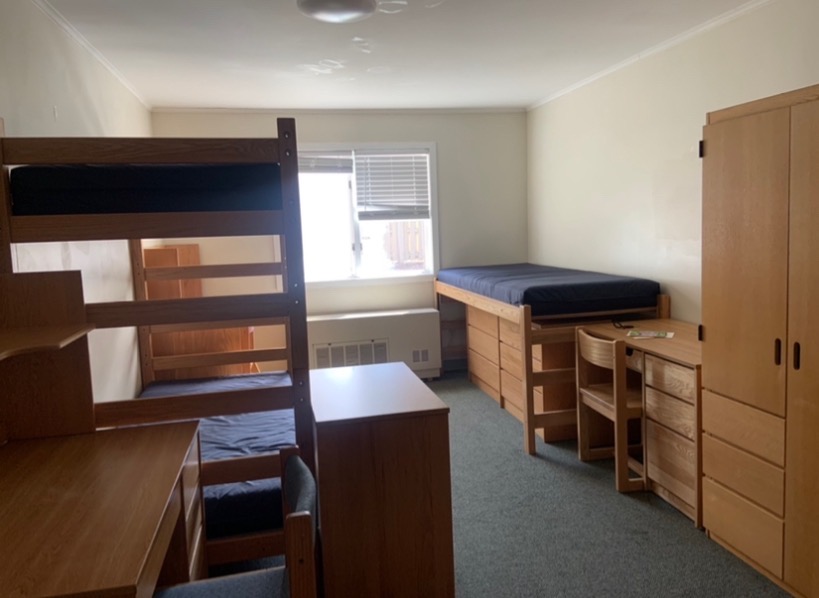Gate House Doubles Converted to Triples
Rooms that were formerly doubles in first-year residence hall Gate House are now triples. The addition of a bed in the form of a bunk bed — as well as an additional desk, chair and dresser — will now allow the hall to accommodate more students.
The Office of Residential Life made the decision to change Gate House’s traditional doubles into triples this year, according to Kim Cataldo-Murray. Cataldo-Murray is the Residential Life Area Director for Brown Commons, which includes Gate House.
“Due to Colgate’s impressive acceptances this year, we needed to secure additional bed space that would be comfortable for our incoming students to be able to join the returning students,” Cataldo-Murray told The Maroon-News in an email.
Cataldo-Murray explained that the Office of Residential Life decided to increase capacity in Gate House, specifically, for several reasons.
“Gate House was chosen as the building to convert rooms into triples based on the size of the rooms and the amenities of the building,” she said. “Gate House rooms offer the most space for three students to live comfortably together when compared to our other residential facilities.”
Located behind the O’Connor Campus Center (the Coop), Gate House was originally designed as a temporary residence for students in 1994 following the entrance of a particularly large class, but it remains as student housing to this day.
Adding another set of furniture in each room forces the Gate House dorm rooms to undergo a few layout changes, first-year and Gate House resident Gisele Tjan said.
“There are two beds that are opposite from each other, and then one bed is stacked on top of another to make bunk beds,” Tjan said. “The desks are [on] either side of the bunk bed, and then one next to the free-standing bed. There are two drawers under the freestanding bed and one drawer next to the bunk bed.”
Student reactions to Gate House’s transformation vary. Some, such as senior Annie Alissi, expressed their dissatisfaction with the new arrangement. Alissi lived in a Gate House double her first year and argued that the new triples are not feasible living situations.
“I think that’s a little bit absurd, because it was definitely roomy for a double but it’s not fit for a triple,” Alissi said.
Other students, though displeased with the new triples, can understand the reasoning behind the decision made by the Office of Residential Life.
“I think it’s unfortunate,” junior Jamie Anderson, the current Community Leader for Gate House, said. “It’s definitely going to make my life much more difficult, just with the [additional] residents on my floor. However, it does make sense because Gate House rooms are the biggest; they have the most spacious area to fit three beds in. So I understand why they chose Gate House.”
Tjan chooses to see the bright side, believing that although the situation is not ideal, it is sustainable.
“I thought it was going to be smaller. I think these rooms would have been pretty big rooms if it had just been doubles, and then maybe being triples makes them a little bit cramped just because my set of drawers is in front of my bed and instead of up against the wall or something, but it’s really not bad. I don’t mind,” Tjan said.
Anderson worries about potential issues that may arise from Gate House residents sharing closer quarters.
“I do predict more roommate conflicts,” Anderson said. “How I’m handling it is working on my mediation skills, I suppose. [I will] make sure they really do the roommate agreements with some sort of baseline to resolve arguments.”
Cataldo-Murray offered advice and possible solutions from the Office of Residential Life for first years who may be frustrated with their triple situation.
“Open communication, setting boundaries early on, and a general attitude of patience will go far when living with others,” Cataldo-Murray explained. “If for any reason students aren’t able to make their space comfortable, we are allowing Gate House residents to request (through their Community Leaders and Area Directors) the removal of storage furniture, such as wardrobes or dressers. These requests will be filled as soon as possible after move-in is over, and are all subject to the professional staff member’s discretion.”

Reade Fenner is a sophomore from Olney, MD with a prospective concentration in economics and a minor in philosophy. She has previously served as a staff...











